Key takeaways:
- Tracking energy consumption helps identify habits and peaks in usage, leading to informed decisions and cost savings.
- Utilizing technologies like smart meters, apps, and home energy monitors enhances awareness of energy usage and empowers sustainable living choices.
- Implementing simple changes, such as switching to LED bulbs and adjusting laundry schedules, can significantly reduce energy bills.
- Analyzing energy data reveals patterns that enable further optimization of consumption habits and encourages mindful usage.
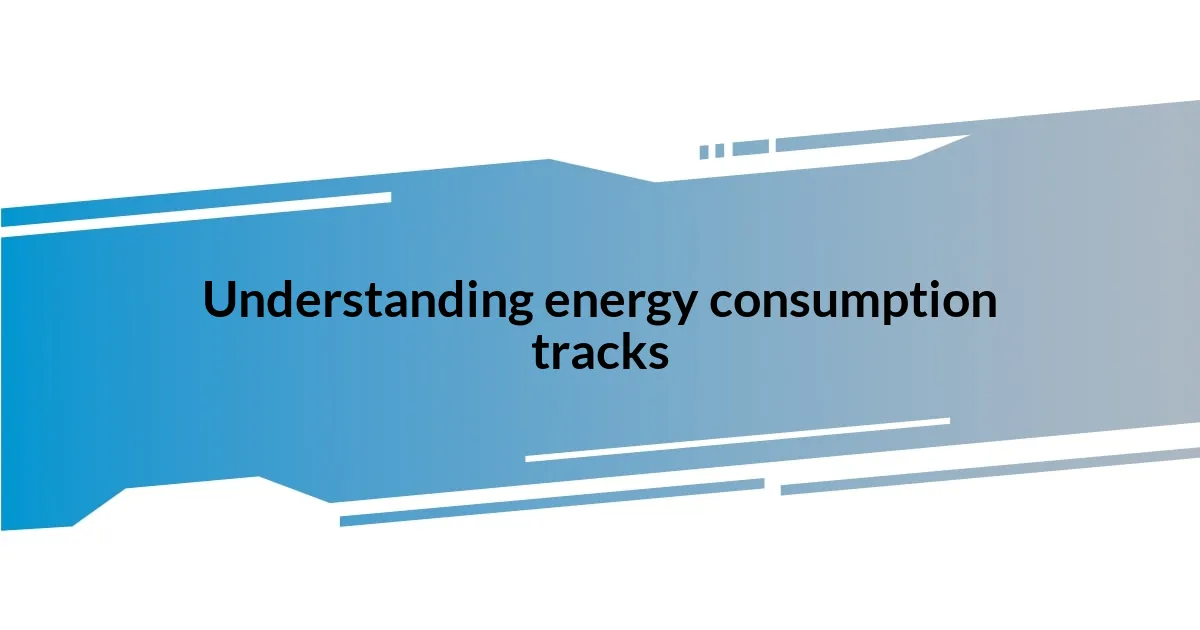
Understanding energy consumption tracks
Understanding energy consumption tracks involves recognizing how much energy we use and when. I remember the first time I installed a smart meter; I was amazed at how it provided real-time data on my energy usage. Seeing my consumption patterns shift according to my daily routines was eye-opening and made me rethink my habits.
Tracking energy consumption is like reading a personal diary of our habits. Each spike and dip in the graph tells a story about our day-to-day activities. Have you ever wondered why your energy usage peaks on certain days? I started noticing mine aligned with laundry days or when I was binge-watching my favorite series. That awareness prompted me to adjust my habits, leading to significant savings over time.
One of the most enlightening aspects of tracking energy is realizing the impact of small changes. For example, after understanding my home’s energy trends, I decided to switch to energy-efficient lighting. The resulting drop in my consumption was not just satisfying but also infused me with a sense of responsibility towards sustainable living. Isn’t it empowering to know that our choices can make a difference?
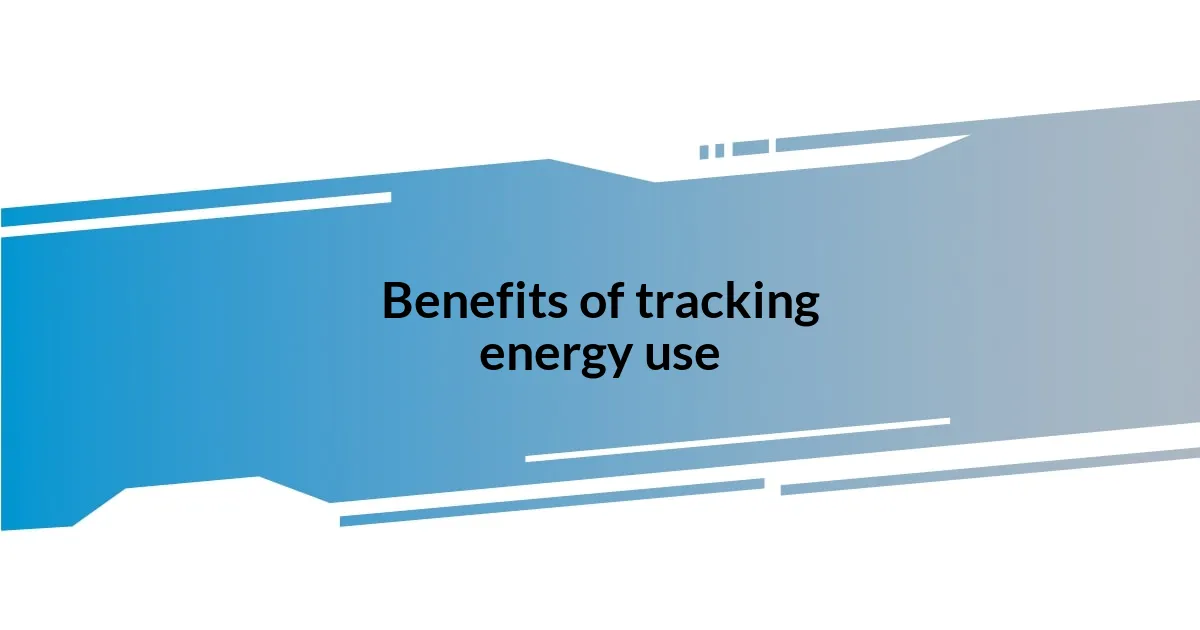
Benefits of tracking energy use
Tracking energy use isn’t just about numbers; it’s a gateway to understanding our daily interactions with power. I remember the thrill of identifying the exact hour my children hogged the television on weekends. Once I pinpointed that spike, I engaged them in making conscious choices about screen time, and that dialogue opened up opportunities for family activities instead of passive consumption. It became a fun challenge for us, turning energy monitoring into a bonding experience.
Here are some of the key benefits I’ve experienced from tracking energy use:
- Cost Savings: By knowing when and where I waste energy, I’ve managed to cut my monthly bills significantly.
- Informed Decisions: It empowers me to invest in energy-efficient appliances by weighing their long-term benefits versus costs.
- Environmental Impact: Understanding my consumption helps me feel more connected to global efforts in reducing carbon footprints.
- Habit Formation: Regularly checking my usage has naturally led to mindful energy-saving habits, like switching off lights when not in use.
- Goal Setting: I’ve been able to set realistic energy-saving goals for my household, making it a rewarding endeavor every month.
Each of these benefits reinforces my belief that tracking energy is vital. It’s not merely about reduction; it resonates with our desire for a conscious, meaningful lifestyle.
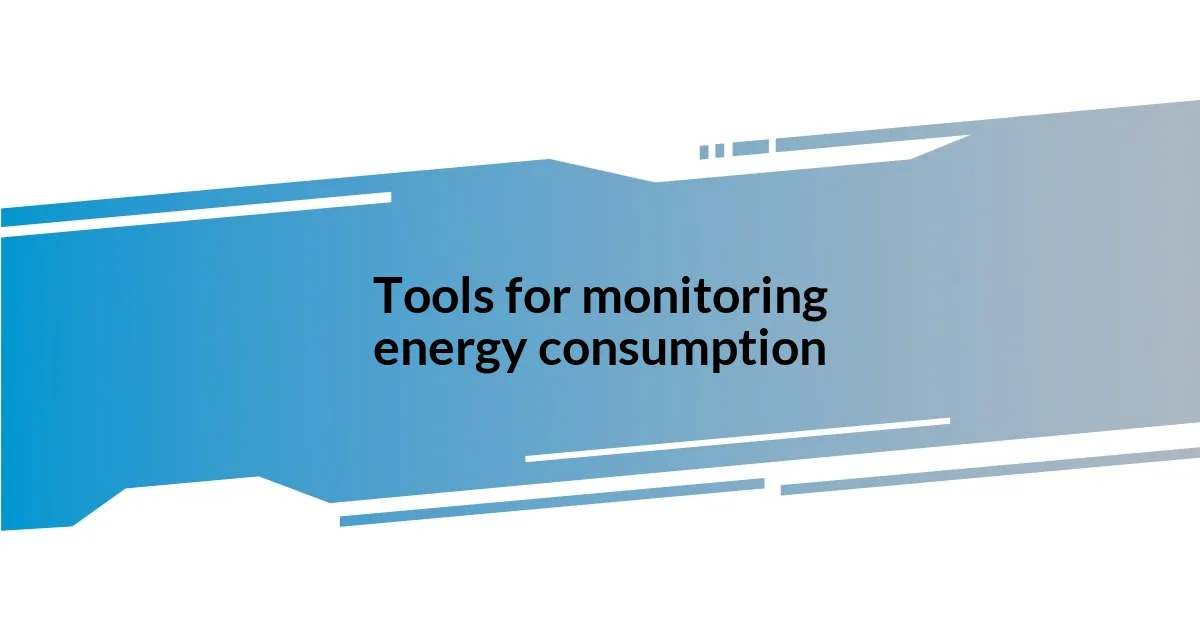
Tools for monitoring energy consumption
When it comes to tools for monitoring energy consumption, I’ve found several options that cater to different needs. For instance, smart meters give a comprehensive snapshot of my energy use, but what about the convenience of smartphone apps? The first time I downloaded one, I felt like I had a personal trainer for my electricity—immediate feedback on my habits motivated me to make real changes.
Additionally, home energy monitors have become increasingly popular. I remember installing one in my circuit panel and, surprisingly, it pinpointed which devices consumed the most power. Just knowing my old refrigerator was a major culprit pushed me to consider an upgrade that I had been delaying. It’s remarkable how uncovering hidden energy hogs can lead to significant reductions in consumption.
Here’s a comparison of different energy monitoring tools:
| Tool | Description |
|---|---|
| Smart Meters | Provide real-time energy usage data and can help identify trends. |
| Smartphone Apps | Allow easy tracking, notifications, and tips for saving energy. |
| Home Energy Monitors | Track usage at the circuit level, showing which appliances consume the most. |
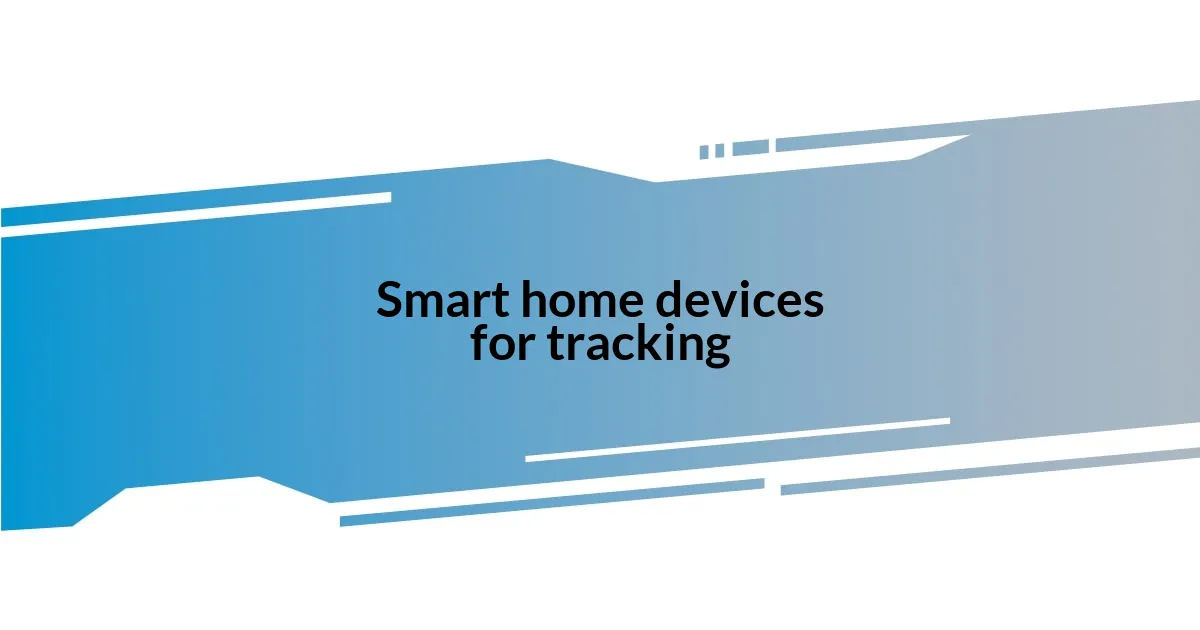
Smart home devices for tracking
Smart home devices have revolutionized the way I track my energy consumption. Recently, I invested in smart plugs that allow me to monitor the usage of individual appliances. It’s astonishing how just plugging in my kitchen devices transformed my understanding of their energy demands; I discovered my coffee maker used more power than I expected. Isn’t it eye-opening to realize that a small device could impact my bill significantly?
Another gadget that really impressed me is the smart thermostat. I recall the first month of using it, and I was amazed at how it adjusted the temperature based on my routines. It not only optimized my energy use but also made my home more comfortable. Have you ever had a device that felt like it knew your habits better than you did? In my experience, it was like having a personal assistant for my home’s climate.
Lastly, I can’t overlook the power of energy monitoring apps that sync with my smart devices. The analytics they provide are striking—seeing real-time data and historical patterns changed my perspective entirely. I remember one late evening when I received an alert about unusual usage levels; it prompted me to check my devices and turn off a forgotten lamp. What a relief it was knowing I could catch these oversights instantly, all thanks to the app!
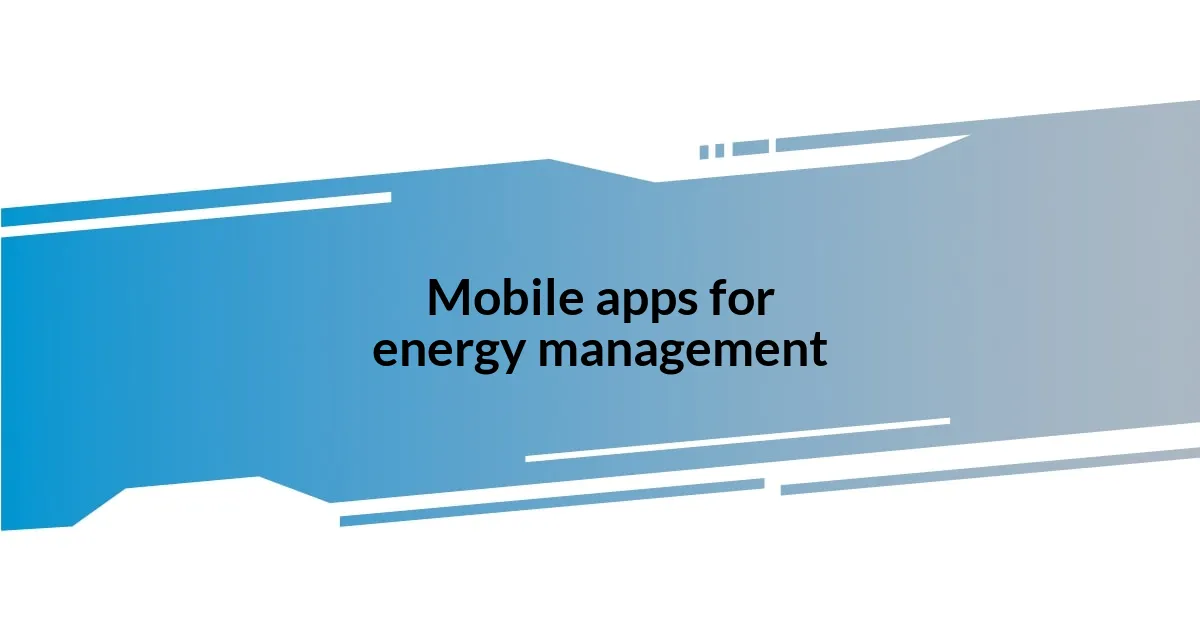
Mobile apps for energy management
Mobile apps for energy management have become essential tools for anyone looking to gain control over their consumption. I remember the first time I utilized an app that connected to my smart meter. The user-friendly interface instantly presented data in ways that made it easy to grasp my energy usage patterns. It felt like unlocking a treasure trove of insights, especially when seeing a visual graph of my daily consumption; it pushed me to make more conscious decisions about usage.
One app, in particular, sent me notifications when my energy usage spiked during peak hours. Initially, I thought, “Does this really make a difference?” But then I started adjusting my habits, like running the dishwasher during off-peak times, and soon enough, I noticed a dip in my bill. It was empowering to act on these alerts, as if I was taking the reins of my energy consumption rather than letting it control me.
The community features in some of these apps have also been surprising. Sharing my experiences and exchanging tips with others striving for the same goals fostered a sense of camaraderie. I recall joining a challenge through one app to reduce consumption over a month—the friendly competition motivated me more than I expected. Have you ever joined a group effort that changed your perspective on something? It definitely enhanced my commitment to tracking my energy, proving that sometimes we all need a little push to stay on the right path.
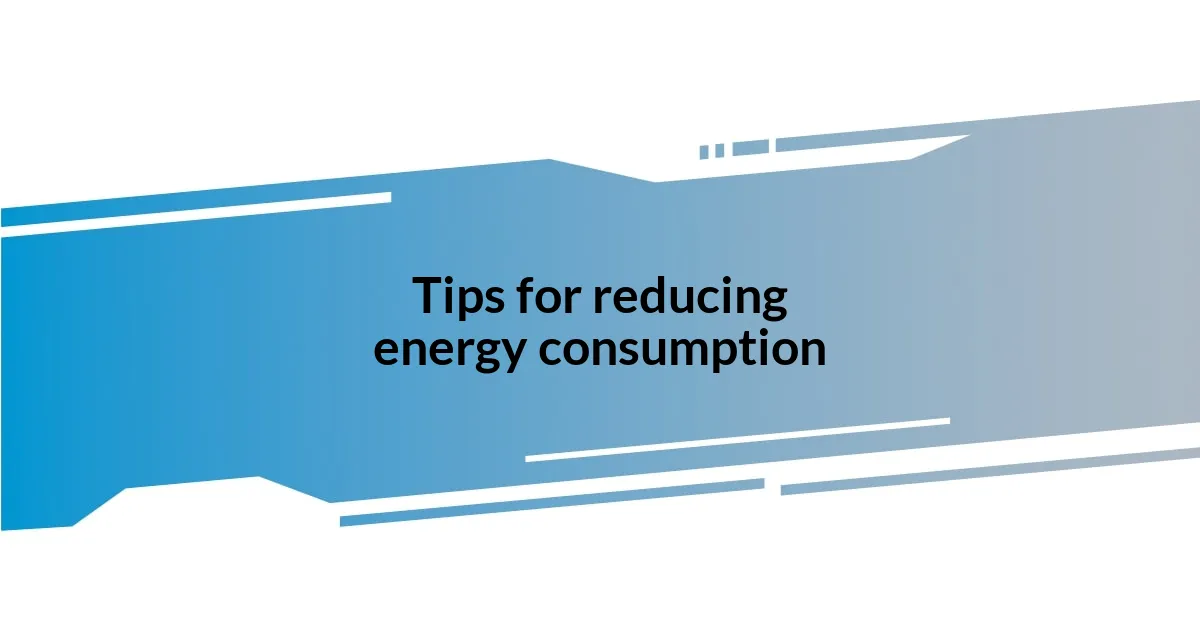
Tips for reducing energy consumption
Keeping an eye on energy consumption isn’t just about technology; it’s also about small habits that can have a big impact. For example, I started unplugging chargers and appliances when I wasn’t using them. It’s surprising how much “phantom” energy these devices consume! Now, whenever I walk past an outlet, I ask myself, “Is that really necessary?” Just that little mindful moment has led to noticeable savings on my energy bill.
Another practice I’ve found incredibly effective is changing my lighting to LED bulbs. Initially, I was resistant to the idea because of the upfront cost, but I can’t emphasize enough how quickly they paid for themselves. Not only do they consume much less power, but they also last longer, reducing waste and replacement costs. Every time I flick a switch, I feel a sense of accomplishment knowing I’m making a smarter, more sustainable choice. Does that kind of change resonate with you?
Finally, timing my laundry can make a big difference, too. I’ve developed a habit of doing laundry during the late evening or early morning when energy rates tend to be lower. It’s a simple shift, but I remember the first time I set my washing machine’s timer—checking the rates felt like playing a fun game! Have you tried adjusting your schedule to see if it can help your wallet? I was pleasantly surprised by how much my bill dropped after making this adjustment.
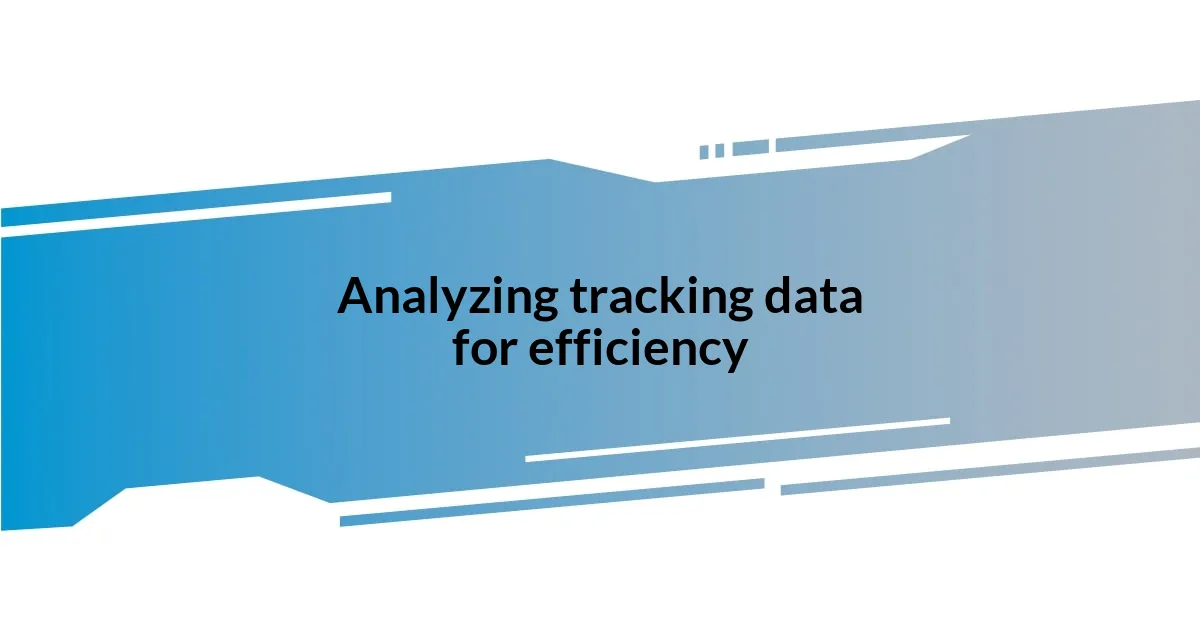
Analyzing tracking data for efficiency
When I first delved into analyzing my tracking data, I was amazed at how revealing those numbers could be. By comparing my energy usage week over week, I began to identify patterns and anomalies that I hadn’t noticed before. For instance, I discovered that my late-night scrolling habit gobbled more energy than I thought. Have you ever looked closely at your own habits and realized they might be costing you?
Digging deeper into the data, I started correlating my consumption with specific activities. I noted that cooking dinner in the evening caused a noticeable spike compared to other times of the day. This realization prompted me to experiment with meal prepping, which not only streamlined my evenings but also meant I could shift some cooking to cheaper off-peak hours. I found myself asking, “What other areas can I optimize?”
Through this ongoing analysis, I learned that understanding your energy consumption is not just about the figures; it’s about using those insights to drive meaningful change. Tracking and reflecting on my data became a sort of game. The challenge of reducing my usage spurred me on, making me feel like I was competing against myself. How often do you find motivation in revisiting past performance? For me, each reduction felt like a mini-victory, bolstering my commitment to efficiency and sustainability at home.